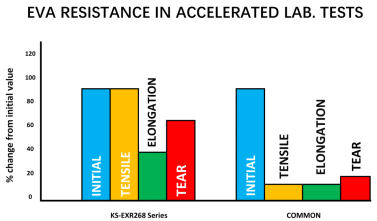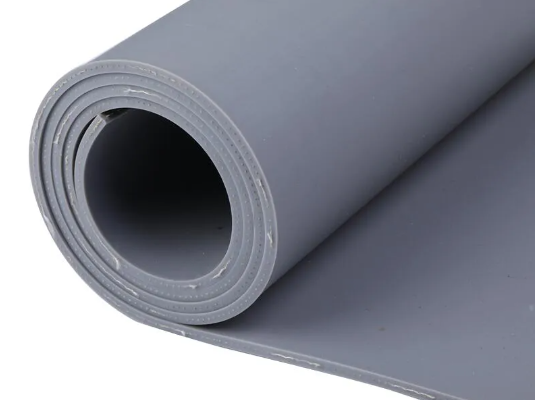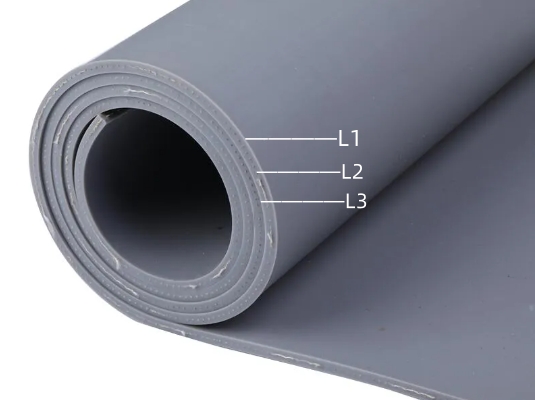Close search
Categories: Silicone Membrane Silicone membrane for PV industry
> Super wide width increases more utilization rate and selection.
> Very tight elongation features – resistant to excessive stretching and sagging.
> Fabric insertion and a unique covering layer with more than 6,000 times life cycle for dual-chamber(cavity) machine.
>Tough materials with tensile strength and tear resistance that are higher than those of traditional membrane materials.


Test Methodology: Membrane sample placed in chamber in close contact to EVA sheet. Exposed for 4 hours at 249 ℃. Hardness, tensile strength, elongation and tear strength properties of membrane tested before and after exposure.
Material | Silicone | |
Color | Grey, Blue, Black | |
Surface | Smooth/Textured | |
Reinforcing Layer | 1 Ply Premium Grade Kevlar Fabric | |
Hardness | EVA Resistant Working Surface (Grey, Blue, Black Silicone) | Working Surface (Grey, Blue, Black Silicone) |
68+/-3 Shore A | 66+/-3 Shore A | |
Density | 1.25 ± 0.05g/cm3 | |
Tensile Strength | 12.5MPa | |
Tear Strength | 48N/mm | |
Temperature resistance | -60℃~+250℃ | |
Elongation | 600% | |
Compression Set | 2% | |
Resilience | 30% | |
Width | Max up to 3780mm |
Material thickness | 3 or 4 mm |
Country | Sizes |
USA | 4mm x 2550 x 6550 |
Mexico | 4mm x 2600 x 4100 |
Morocco | 4mm x 2000 x 2400 |
India | 4mm x 2550 x 5720 |
Jordan | 4mm x 2760 x 4960 |
Turkey | 4mm x 2650 x 4730 |
Vietnam | 4mm x 2800 x 4100 |
Philippines | 4mm x 2500 x 4100 |
South Korea | 3mm x 2755 x 4925 |
Germany | 4mm x 2410 x 4500 |
Poland | 4mm x 2200 x 3700 |
Silicone membranes for solar laminators, Casis products can match a variety of laminator brands and types. Depending on the solar module production line requirements, a solar panel laminator from 3S, Meier, Bürkle, Komax, Electro Solar or others is integrated.
World-wide producers of thin film and crystalline solar panels face corrosive attacks on Silicone Sheets used on lamination equipment.

During the lamination / encapsulation process of EVA volatile outgassing occurs. Outgassing refers to unwanted chemicals that are usually a bi-product of the process and temperature. These acidic fumes are emitted from adhesive or other components and can lead to corrosion of the Sheets. This corrosion manifests itself in surface degradation (cracks) + excessive stretching and sagging.
But KS-EXR268 series solves all the above problems well, because It’s a composite material that resists the deterioration caused by EVA outgassing. In addition it is a really tough material with both tensile strength and tear resistance higher than traditional Membranes materials. This makes Lamination particularly durable and increases your machine running times.
Besides,KS-EXR268 series has very tight elongation features – resistant to excessive stretching and sagging. Customers’ feedback indicates that this series may give up to 50% longer life than some traditional Diaphragm materials – obviously dependent upon type of module, encapsulant and conditions.
What’s the best silicone membrane for solar modules lamination?
This is really a vital question and can be best discussed together face-to-face. There is no one answer that is right for everybody. There are many determining factors that can affect the choice of silicone membranes. For example type of encapsulant, the composition of the modules, size of the modules, a brand of laminator, and budget constraints, etc.
How long should a silicone membrane last?
Commonly our data shows that KS-EXR268 - 6,000 cycles for dual-chamber(cavity) machine + KS-EXR668 - more than 12,000 cycles for dual-chamber(cavity) machine.. As there are a number of variables beyond our direct control, it is very difficult to “guarantee” an exact cycle life.
Does color or surface finish have any impact on membrane performance?
Based on feedback from customers worldwide, we can see no advantage or disadvantage of different colors, or indeed surface finish. Actually, colors are now used to differentiate between suppliers.
How can we tell the difference of Casis solar silicone membranes?
As technology progresses, there are three types of silicone membranes for the solar industry. Please check or download below technical data sheet for your further distinction.



How long should a diaphragm last?
This also depends on your encapsulant and type of module. Give us a call or email to talk about your product and processes to determine what you should be getting from your membrane.
What can we do to extend the life of our membrane?
Consider protecting it with a layer of PTFE sheet between the modules and the membrane. We have several options for this. And if you’re encapsulating with EVA, we should recommend KS-EXR268 Silicone membrane that is resistant to the outgassing from the EVA. The KS-EXR268 option may give you far better life than your current membrane.
During laminating the solar PV panels, the silicone rubber membrane transfers the laminator’s temperature and pressure to modules. The good silicone membranes work at least 6,000 laminating cycles with good EVA-resistant ability.
KS-EXR268 Series is a specially developed membrane consisting of a silicone backing material and a unique covering layer. This covering layer is extremely resistant to outgassing and related decomposing processes of EVA films. This makes our membrane particularly durable and increases your machine running times.
It has an EVA resistant fluorine laminated surface with additional fabric reinforcement.
Structure
1# Grey silicone - working layer
2# 1 Ply premium Kevlar fabric reinforcement
3# Grey silicone - working layer

In the process of solar photovoltaic panel's lamination, the panel manufacturers encapsulate all components with ethylene-vinyl acetate (EVA) adhesive film to ensure that module layers remain secure. That will cause high heat to melt the EVA (typically 145-155°C). That's why those makers need our flexible, resilient, and durable silicone rubber sheet designed for use in the solar laminators to provide compression on the PV panes in repeated cycles.
